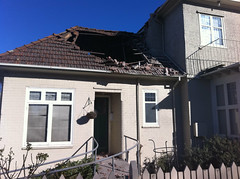
Search
Images for hole; more images...
WEMO ERT Set 4 - March 2011 - Photograph 11
Images, UC QuakeStudies
A photograph of a sign taped to a window. The sign includes a bullet pointed list of humorous observations about Christchurch following the February 2011 earthquake. The sign reads, "You know you're from Christchurch when: you use the term 'liquefaction' and 'seismic design' in casual conversation; digging a hole and shitting in your garden is no longer weird; your mayor describes the city as munted. If he means FUBARed, you agree; weaving through car size potholes on the street is no longer weird; a shower is heaven; you have a preference of which kind of silt you'd rather shovel, dry or wet; you see tanks...driving around town; you are always noting what you are under; due to frequent aftershocks during the night, you sleep like a baby - every 10 minutes you wake up and shit yourself".
Vulnerability and Resilience Assessment of the New Zealand Telecommunicati…
Research papers, University of Canterbury Library
Nowadays the telecommunication systems’ performance has a substantial impact on our lifestyle. Their operationality becomes even more substantial in a post-disaster scenario when these services are used in civil protection and emergency plans, as well as for the restoration of all the other critical infrastructure. Despite the relevance of loss of functionality of telecommunication networks on seismic resilience, studies on their performance assessment are few in the literature. The telecommunication system is a distributed network made up of several components (i.e. ducts, utility holes, cabinets, major and local exchanges). Given that these networks cover a large geographical area, they can be easily subjected to the effects of a seismic event, either the ground shaking itself, or co-seismic events such as liquefaction and landslides. In this paper, an analysis of the data collected after the 2010-2011 Canterbury Earthquake Sequence (CES) and the 2016 Kaikoura Earthquake in New Zealand is conducted. Analysing these data, information gaps are critically identified regarding physical and functional failures of the telecommunication components, the timeline of repair/reconstruction activities and service recovery, geotechnical tests and land planning maps. Indeed, if these missing data were presented, they could aid the assessment of the seismic resilience. Thus, practical improvements in the post-disaster collection from both a network and organisational viewpoints are proposed through consultation of national and international researchers and highly experienced asset managers from Chorus. Finally, an outline of future studies which could guide towards a more resilient seismic performance of the telecommunication network is presented.
Greening the rubble in Christchurch: Civic ecological reclamation efforts …
Research Papers, Lincoln University
Within four weeks of the September 4 2010 Canterbury Earthquake a new, loosely-knit community group appeared in Christchurch under the banner of “Greening the Rubble.” The general aim of those who attended the first few meetings was to do something to help plug the holes that had already appeared or were likely to appear over the coming weeks in the city fabric with some temporary landscaping and planting projects. This article charts the first eighteen months of Greening the Rubble and places the initiative in a broader context to argue that although seismic events in Christchurch acted as a “call to palms,” so to speak, the city was already in need of some remedial greening. It concludes with a reflection on lessons learned to date by GTR and commentary on the likely issues ahead for this new mini-social-environmental movement in the context of a quake-affected and still quake-prone major New Zealand city. One of the key lessons for GTR and all of those involved in Christchurch recovery activities to date is that the city is still very much in the middle of the event and is to some extent a laboratory for seismic and agency management studies alike.
